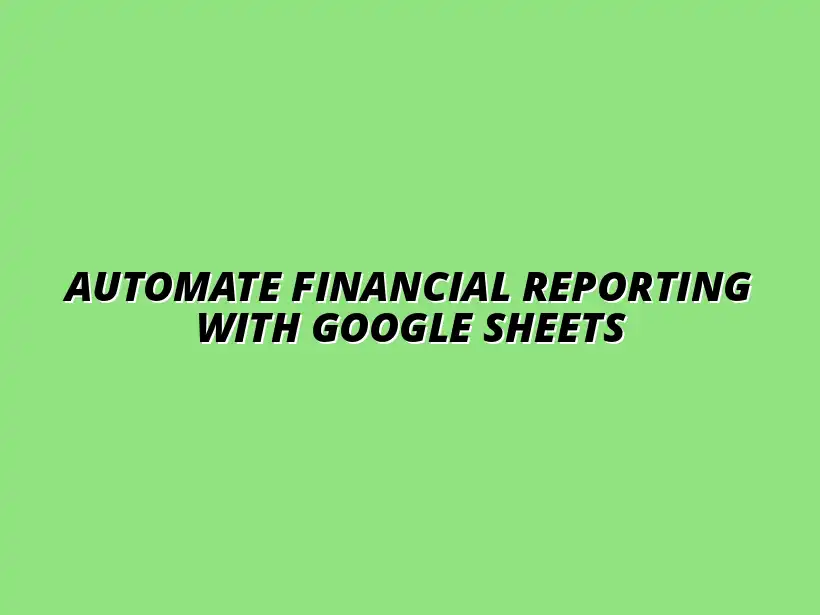
Automate Financial Reporting with Google Sheets
Understanding Google Sheets Automation for Financial Reporting
In the realm of financial reporting, efficiency is key. That's where Google Sheets automation comes into play. This powerful tool streamlines repetitive tasks, allowing finance teams to focus on analysis rather than data entry.
Automation not only saves time but also enhances the overall accuracy of financial reports. By reducing manual processes, teams can minimize the risk of errors that often come with handling numbers. A well-set automation system in Google Sheets provides a clear path to insightful financial management! To learn more about streamlining your reporting, check out this helpful guide on streamlining reporting with Google Sheets.
The Importance of Automation in Financial Reporting
Implementing automation in financial reporting is not just a trend; it's a necessity! Teams benefit significantly from automating tedious tasks, which leads to a more efficient workflow and quicker access to data. This advantage allows businesses to make informed decisions based on timely financial insights.
Moreover, automation enhances consistency across various reports. With standardized processes, it becomes easier to compare data over different periods or departments. As a result, finance teams can ensure that they are not only accurate but also providing reliable information across the board. Discover how to automate reports with Google Sheets and unlock significant efficiency gains.
Benefits of Streamlining Financial Processes
Streamlining financial processes brings numerous benefits that can transform a team’s performance. Here are some key advantages:
- Time Savings: Automation eliminates the need for manual entry.
- Cost Efficiency: Reducing errors can lower operational costs.
- Enhanced Reporting Speed: Faster access to financial data allows for quicker decisions.
- Improved Compliance: Consistent processes support regulatory compliance.
Reducing Errors and Enhancing Accuracy
Error reduction is one of the most crucial advantages of automation. Financial reports filled with mistakes can lead to poor decision-making and damage credibility. By relying on automated systems in Google Sheets, teams can achieve a higher level of data integrity.
Additionally, when data is automatically updated, it ensures that the latest information is being used. This accuracy helps in making reliable forecasts and assessments. Consequently, finance teams can present reports with a greater degree of confidence! Learn how to streamline data management with Google Sheets to improve accuracy and efficiency.
Key Features of Google Sheets for Financial Reporting
Google Sheets is packed with features that are highly beneficial for financial reporting. These features not only enhance productivity but also foster collaboration among team members. Understanding and utilizing these tools can lead to more effective financial management.
Among these features, the ability to share documents in real time stands out. Teams can work simultaneously on the same report, which reduces the chances of miscommunication and enhances efficiency. Let's take a closer look at some of the key features! Improve your data visualization skills with these Google Sheets data visualization tips.
Collaboration Tools for Team Efficiency
The collaboration tools in Google Sheets are designed to make teamwork seamless. Key tools include:
- Real-Time Editing: Multiple users can edit simultaneously.
- Commenting: Team members can leave feedback directly on the document.
- Version History: Easily track changes and revert to previous versions.
- Share Settings: Control who has access to view or edit files.
Integration with Other Financial Tools and Systems
Another significant feature of Google Sheets is its ability to integrate with various financial tools and systems. This capability makes it easier to pull data from different sources, ensuring comprehensive reporting. Common integrations include:
- Accounting Software: Syncing data from applications like QuickBooks.
- CRM Systems: Pulling customer data for financial analysis.
- Data Visualization Tools: Creating charts and dashboards for better insights.
- Payment Processors: Tracking transactions for financial reporting.
By leveraging these integrations, finance teams can create more accurate and well-rounded financial reports! Discover how to easily automate Google Sheets reports to save time and increase efficiency.
Best Practices for Continuous Improvement in Financial Reporting
Continuous improvement is essential for effective financial reporting. Regularly updating and refining processes keeps your reports relevant and accurate. It also helps your team adapt to changes in technology and financial regulations, ensuring that your reporting remains efficient and reliable. Learn to streamline your workflow with Google Sheets for enhanced efficiency.
One way to achieve continuous improvement is by establishing a review schedule. This can help you assess what’s working and what’s not, leading to better outcomes over time. Being proactive in your approach allows you to stay ahead of potential issues before they arise!
Regularly Updating and Reviewing Reporting Processes
Setting a dedicated schedule for reviewing your financial reporting processes can significantly enhance efficiency. A good practice is to conduct these reviews quarterly or bi-annually. This allows for the necessary adjustments based on your business’s evolving needs or any feedback received.
Incorporating feedback from stakeholders is also crucial. Their insights can provide valuable perspectives on how reports are used and what improvements can be made. By actively seeking input, you can ensure that your financial reporting aligns with overall business goals!
- Schedule regular review meetings.
- Gather feedback from team members and stakeholders.
- Analyze performance metrics to identify areas for improvement.
- Implement changes and monitor their impact.
Establishing a Schedule for Review and Refinement
To effectively establish a review schedule, consider creating a calendar that highlights key review dates. Regularly scheduled check-ins allow your team to stay organized and focused. Additionally, having a timeline for updates encourages accountability within your team.
Utilizing project management tools or shared calendars can help keep everyone aligned on review dates. By marking these dates clearly, team members will be reminded to prepare necessary data for evaluation. This way, the review process becomes a team effort!
Incorporating Feedback from Stakeholders
Gathering feedback from stakeholders ensures that your financial reports meet their needs. Conducting surveys or organizing feedback sessions can facilitate open discussions. This engagement not only improves your reports but also boosts team morale and collaboration.
When implementing feedback, it’s essential to prioritize suggestions based on impact and feasibility. Not every piece of feedback will lead to immediate changes, but keeping a record of input can help you identify trends over time. This process of continuous improvement creates a culture of collaboration!
Staying Informed on Google Sheets Updates and Features
Keeping up with the latest updates from Google Sheets can enhance your financial reporting capabilities. Google frequently rolls out new features, and being aware of these can help you take advantage of them. Regularly checking for updates ensures you’re leveraging the full potential of the platform! Learn how to automate Google Sheets with Apps Script to unlock advanced automation features.
Utilizing Google’s official resources, such as their support pages and blog posts, is a great way to stay informed. These resources provide tips, tricks, and tutorials that can help you improve your understanding of Google Sheets and its functionalities.
- Follow Google’s official blog for updates.
- Bookmark helpful resources and tutorials.
- Subscribe to newsletters focused on Google Sheets.
- Engage with Google’s online help community.
Utilizing Google’s Official Resources for Learning
Google offers a variety of official resources, including documentation and video tutorials. These materials cover everything from basic functions to advanced features, making it easy to learn at your own pace. By utilizing these resources, you can sharpen your skills and enhance your financial reporting.
Consider participating in webinars hosted by Google or other learning platforms. These interactive sessions allow for real-time questions and answers, providing deeper insights into how to use Google Sheets effectively for financial reporting!
Participating in Google Sheets User Communities
Joining user communities can provide tremendous value. Here, you can connect with other users, share experiences, and learn new strategies. These communities often offer solutions to common problems, making them a great resource for continuous improvement.
Social media groups, forums, and online platforms like Reddit or LinkedIn can be excellent places to find these communities. Engaging with fellow users can expose you to new approaches and best practices that can elevate your reporting processes!
Frequently Asked Questions About Google Sheets Automation
As you dive deeper into Google Sheets automation, you might have questions. Addressing common queries can help clarify the benefits and limitations of automation in financial reporting. This section aims to provide clear answers to frequently asked questions, ensuring you feel confident moving forward!
Understanding how automation can save you time and what its limitations are is crucial for successful implementation. Let’s explore some common questions and provide insightful answers!
Addressing Common Queries Related to Automation
Many people wonder, “How can Google Sheets automation save time in reporting?” The answer lies in its ability to streamline repetitive tasks, reduce manual data entry, and enhance data accuracy. By automating these processes, you can dedicate more time to analysis and strategic decisions!
Another common question is, “What are the limitations of using Google Sheets for financial reporting?” While Google Sheets offers numerous advantages, it’s essential to recognize its constraints. For larger datasets, performance may lag, and advanced financial modeling might require more specialized tools.
How Can Google Sheets Automation Save Time in Reporting?
Google Sheets automation can significantly enhance your efficiency by:
- Automating data entry from various sources.
- Generating reports with a single click.
- Reducing the time spent on repetitive calculations.
- Minimizing human errors in data processing.
By implementing automation, your team can focus on strategic tasks rather than mundane data management. This shift allows for faster decision-making and improved financial performance!
What Are the Limitations of Using Google Sheets for Financial Reporting?
While Google Sheets is a powerful tool, it does have limitations that you should consider:
- Performance issues with extremely large datasets.
- Limited capabilities for complex financial modeling.
- Potential security concerns with sensitive financial data.
- Reliance on internet connectivity for access.
Understanding these limitations helps you set realistic expectations and determine whether Google Sheets is the right fit for your financial reporting needs!
Providing Tips for Getting Started with Automation
Getting started with Google Sheets automation doesn’t have to be overwhelming! Here are some basic steps to help you dive into automating your financial reports:
- Identify repetitive tasks that could be automated.
- Familiarize yourself with Google Apps Script basics.
- Explore available add-ons for enhanced functionality.
- Start small and gradually implement more automation.
Taking these initial steps can set you on the right path to transforming your reporting process through automation!
Basic Steps to Begin Automating Your Financial Reports
To begin automating your reports, follow these straightforward steps:
- Assess your current reporting process.
- Determine which tasks can be automated.
- Learn about Google Apps Script and available add-ons.
- Test automation on a smaller scale before full implementation.
By approaching automation methodically, you can ensure a successful transition to more efficient financial reporting!
Resources for Further Learning and Development
To deepen your understanding of Google Sheets automation, consider utilizing the following resources:
- Google’s official documentation and tutorials.
- Online courses on platforms like Coursera or Udemy.
- Webinars and workshops offered by financial experts.
- Books focused on Google Sheets and financial reporting.
These resources can provide valuable insights and skills needed to fully leverage Google Sheets for financial reporting!
Final Thoughts on Leveraging Google Sheets for Financial Reporting
As we wrap up this exploration of Google Sheets automation, it’s clear that the benefits are substantial. Automating your financial reporting processes can lead to increased efficiency, reduced errors, and a more streamlined workflow. Reflecting on the impact of these improvements can motivate you to further explore the capabilities of Google Sheets!
Encouraging a culture of continuous enhancement within your team will ultimately lead to better financial outcomes and informed decision-making. So, don’t hesitate to dive deeper into automation and its potential benefits!
Summarizing Key Points on Automation Benefits
In summary, Google Sheets automation can transform your financial reporting by:
- Saving time on repetitive tasks.
- Enhancing accuracy and reducing errors.
- Facilitating better collaboration within teams.
- Providing real-time data insights.
Embracing these automation benefits can truly elevate your reporting process and help drive your organization’s success!
Reflecting on the Impact of Automation on Reporting Efficiency
Reflecting on how automation affects your reporting efficiency is critical. By measuring improvements in accuracy and time savings, you can make informed decisions about further investments in automation. This practice reinforces the value of staying adaptable to new technologies!
Automation isn’t just about technology; it’s about creating a more efficient and responsive financial reporting environment. This evolution can lead to better business decisions and improved financial health!
Engaging with Community and Resources
Engaging with the community and available resources can greatly enhance your understanding of Google Sheets. Connecting with other users can provide insights and tips that you may not find in official documentation. This shared knowledge can be invaluable as you implement automation!
Inviting readers to share experiences and insights fosters a community of learning and growth. By discussing challenges and successes, we can all learn and improve our financial reporting practices together!
Connecting with Google Sheets Experts and Users
Connecting with experts and other users can provide support and new ideas for using Google Sheets. Networking through forums, social media, or local meetups can lead to fruitful exchanges. These connections can also offer mentorship opportunities as you explore automation!
Don’t be shy! Reach out to those who have successfully implemented automation in their financial processes. They can share valuable lessons learned and best practices that can help guide your journey.
Inviting Readers to Share Their Experiences and Insights
We’d love to hear your stories about using Google Sheets for financial reporting! Sharing your experiences can help others navigate their challenges as well. Whether you’ve faced obstacles or achieved remarkable success, your insights can inspire and educate!
Engaging in discussions within communities or leaving comments on articles can foster collaboration and collective learning. Let’s continue to grow and improve our financial reporting processes together!




